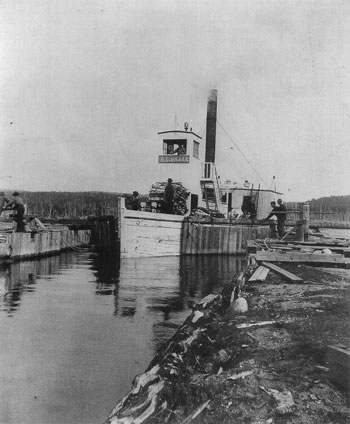B A C K T H E N
Bark Steamers

About 1890. The sternwheel steamer H.L. Drake locking through at Dobsis, between Sistadobsis and Pocumpus Lakes in northeastern Washington County. The Drake, with a running mate, scowed hemlock bark to the former Show Bros. sole-leather tannery at Grand Lake Stream, which, when built, was the world’s largest. The steamers conveyed four scows at a time, two lashed to a side, from landings up to twenty-five miles distant, from Dobsis, Scraggley, and Junior Lakes. Each scow carried twenty-five cord. At Grand Lake Stream a huge bark pile competed with the immense buildings and ever-resent stench for domination of the site.1
Fayette, William, and Thackster Shaw, Boston-based tanners, cut a broad swath through the hemlock belt. In 1870, when they undertook the Grand Lake Stream project, they already owned large tanneries in New York, Canada, and elsewhere in eastern Maine.
The tannery complex was built on a blasted site stripped bare of forest. The sawmill came first, followed by bark mill, leach house, furnace house, the six-hundred-foot tan-yard building, and ten-story dry loft, a roll loft, the underground beam rooms and sweat houses, and support buildings. Nor should we overlook a 350-yard canal, huge penstock, locks, scows, and steamers. As the tannery grew, a scraggly village materialized, while, out in the woods, hundreds of men with horses peeled, stacked, and hauled thousands of cords of bark.
Many of the construction workers were Quebec French. The regular workers were mostly Provincials, along with an assortment of other nationalities. Entire families shared single rooms. Wages were low, but newly arrived hopefuls worked out their keep on a farm owned by the Shaws while awaiting an opening.
There was no paint, inside or out. A big company store salvaged as much of the payroll as possible. The village was landscaped with boulders, stumps, and rubble, and the stream, polluted by sawdust and filth. Carts ladden with reeking beam-room refuse, intended for fertilizer, dripped and slopped along the rough roads, distributing the bounty far and wide.
Drunkenness was common, yet violence and serious crime were rare. There was no law officer and no doctor, and the seriously injured or ill often suffered several days before professional help arrived. A proposed railway to the tannery was never built, and transporting the hides in and out over the phenomenally rough road, or by the old steamer Captain Lewey, to Princeton, was not an efficient arrangement.
Other Shaw tanneries in Maine were at Kingman, Jackson Brook, Vanceboro, and Forest City; the brothers’ complete holdings of tanneries and extract works totalled thirty-nine. In July 1883, the Shaws’ empire collapsed, shocking Boston financial circles and stunning eastern Maine. Operations were resumed at Grand Lake Stream under new owners, lasting until 1898, when the last act was played out by Boston junk dealers. Fayette Shaw, meanwhile, had moved on to found a new tannery empire in Wisconsin.
The H.L. Drake was financed with the surplus from an insurance settlement after an 1887 fire at Grand Lake Stream that burned the tan yard, beam room, and dry loft. Given the high rate of conflagration in the tannery industry, it seems remarkable that insurance could even be obtained.
A procession of some twenty-six two-horse teams passed through St. Stephen recently on their way to and from the Custom House for being bonded. The teams were collected in New Brunswick by an agent of Shaw Bros. and are intended for bark hauling in the forests of this section for that firm. The team, the greater number of them consisting of fine looking and powerful horses, made a very attractive appearance. It stated that Shaw Brothers require one hundred just such teams to haul bark for them the present winter. – The [Bangor] Industrial Journal, Jan. 5, 1883.
